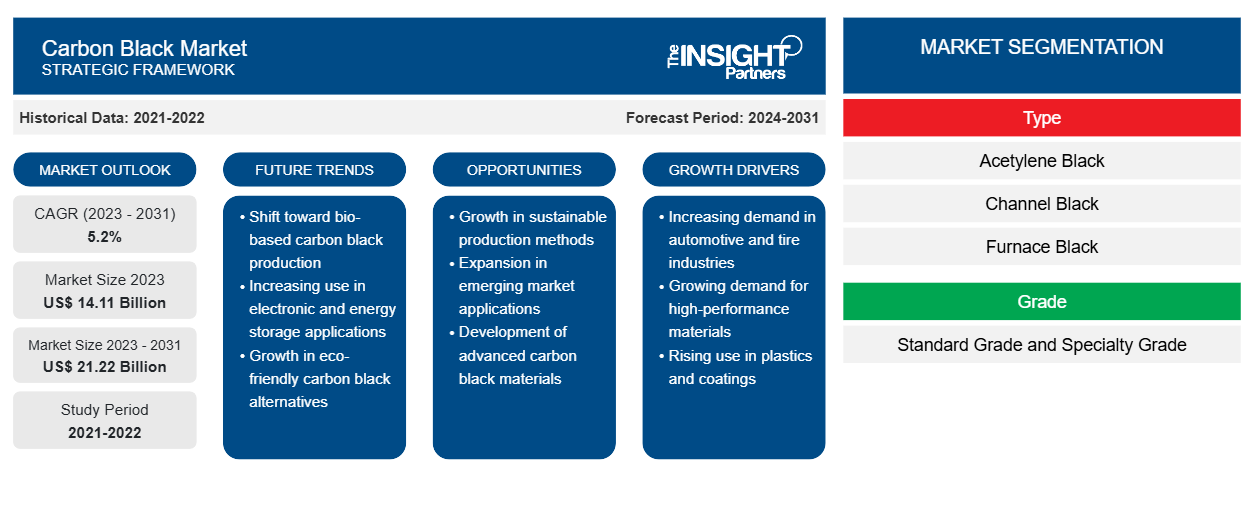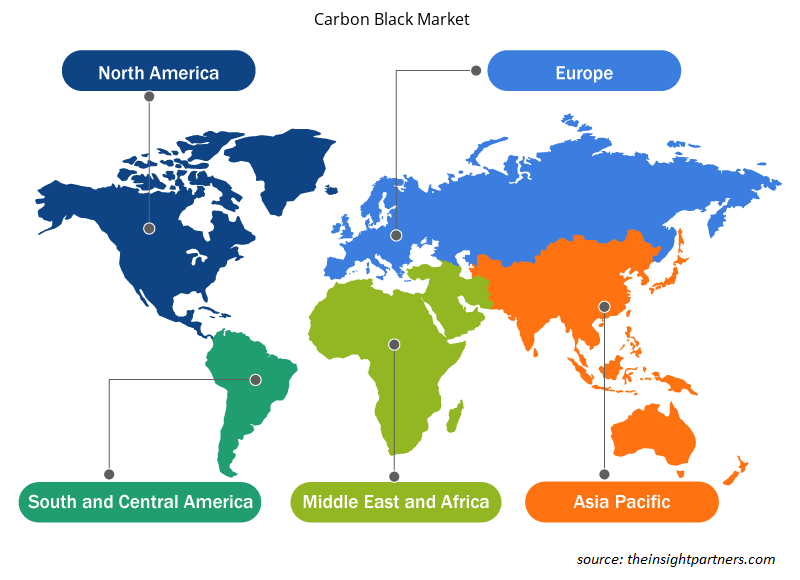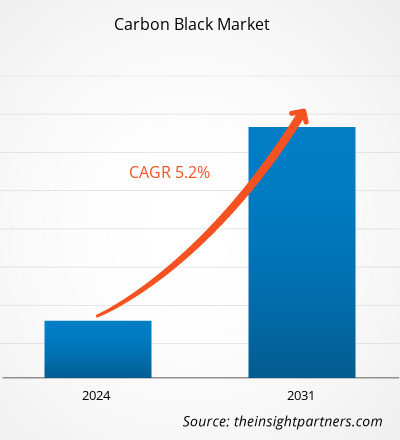من المتوقع أن يصل حجم سوق الكربون الأسود إلى 22.87 مليار دولار أمريكي بحلول عام 2031، مقارنةً بـ 14.92 مليار دولار أمريكي في عام 2023، بمعدل نمو سنوي مركب قدره 6.5% خلال الفترة المتوقعة. ومن المرجح أن يظل التركيز المتزايد على إدارة الإطارات المستعملة أحد الاتجاهات الرئيسية في سوق الكربون الأسود.
تحليل سوق الكربون الأسود
الطلب المتزايد من صناعة السيارات هو المحرك الرئيسي لنمو السوق. يُستخدم الكربون الأسود على نطاق واسع في تصنيع أطوار التعزيز والصبغ في إطارات السيارات نظرًا لقدرته على إطالة عمر الإطار من خلال تقليل التلف الحراري. تُعتبر المواد المختلفة المستخدمة في تصنيع الإطارات عاملاً رئيسيًا في جوانب السلامة والراحة في تصميم السيارات. يُستخدم الكربون الأسود كمادة مضافة في المطاط ، والذي يُستخدم في تصنيع إطارات تُحسّن قوة الشد ومقاومة التآكل. يُعزز حجم سوق الكربون الأسود صناعة المطاط وإطارات السيارات، مع تزايد عدد السيارات حول العالم.
نظرة عامة على سوق الكربون الأسود
يؤثر حجم جسيمات أسود الكربون على المطاط وخصائص لونه. تتميز الأقطار الصغيرة بمساحة سطح أكبر وقوة تلوين أعلى. يُستخدم أسود الكربون بكثرة لتقوية المطاط في الإطارات. كما يمكن استخدامه كمثبت للأشعة فوق البنفسجية، وصبغة، وعامل موصل أو عازل في مجموعة متنوعة من تطبيقات البلاستيك والمطاط والحبر والطلاء. علاوة على ذلك، يُعد أسود الكربون أساسيًا في العديد من المنتجات المستخدمة في العديد من الصناعات. تشمل تطبيقاته الأخرى الخراطيم، وأحزمة النقل، والبلاستيك، وأحبار الطباعة، وطلاءات السيارات.
ستحصل على تخصيص لأي تقرير - مجانًا - بما في ذلك أجزاء من هذا التقرير، أو تحليل على مستوى الدولة، وحزمة بيانات Excel، بالإضافة إلى الاستفادة من العروض والخصومات الرائعة للشركات الناشئة والجامعات
سوق الكربون الأسود: رؤى استراتيجية

-
احصل على أهم اتجاهات السوق الرئيسية لهذا التقرير.ستتضمن هذه العينة المجانية تحليل البيانات، بدءًا من اتجاهات السوق وحتى التقديرات والتوقعات.
محركات وفرص سوق الكربون الأسود
تزايد الطلب على الكربون الأسود المتخصص
أسود الكربون المتخصص هو أنقى أنواعه، ويحتوي على نسبة منخفضة من الكبريت والمعادن والرماد وشوائب أخرى. يُصنع من خلال الاحتراق الجزئي للهيدروكربونات، بما في ذلك النفط والغاز، وذلك لتلبية المواصفات الصارمة وتوفير الوظائف اللازمة وفقًا لمتطلبات الاستخدام النهائي. يُستخدم أسود الكربون المتخصص كعامل تقوية في الأحزمة، والحشيات، وأجهزة عزل الاهتزاز، والخراطيم، والأغشية ، والبطانات، ومصدات الشاسيه، والزنبركات الهوائية، وعجلات النقل، والحلقات المعدنية. بالإضافة إلى ذلك، يُستخدم أيضًا في أكياس النفايات، والحقائب الصناعية، وحاويات التصوير الفوتوغرافي، وأغشية التغطية الزراعية، واللفائف المطاطية، وتطبيقات القولبة بالحرارة للأجهزة الكهربائية/الإلكترونية، والسيارات، والحاويات المصبوبة بالنفخ.
الحاجة المتزايدة إلى البدائل الخضراء
هناك حاجة متزايدة لبدائل خضراء مع تركيز متزايد على الاستدامة. يُسهم الاقتصاد الأخضر في تعزيز التنمية الاقتصادية وتحسين حياة الناس مع تعزيز الرفاه البيئي. يبرز الكربون الأسود الأخضر أو المُعاد تدويره كبديل لكربون الأسود الخام المُصنّع من احتراق النفط الخام. لكربون الأسود المُعاد تدويره فوائد عديدة، إذ يُسهم في خفض انبعاثات ثاني أكسيد الكربون بشكل كبير، ويُركز أيضًا على إعادة استخدام المنتجات لتقليل توليد النفايات. وبالتالي، من المتوقع أن تُتيح الحاجة المتزايدة للبدائل الخضراء، مثل الكربون الأسود الأخضر أو المُعاد تدويره، فرصًا أكبر لنمو السوق.
تحليل تجزئة تقرير سوق الكربون الأسود
إن القطاعات الرئيسية التي ساهمت في استخلاص تحليل سوق الكربون الأسود هي النوع والدرجة والتطبيق.
- يُقسّم سوق الكربون الأسود، حسب نوعه، إلى أسود الأسيتيلين، وأسود القناة، وأسود الفرن، والأسود الحراري، وغيرها. وقد استحوذت شريحة أسود الفرن على حصة سوقية أكبر في عام ٢٠٢٣.
- حسب الدرجة، يُقسّم السوق إلى صنفين: صنف قياسي وصنف متخصص. وقد استحوذ صنف الصنف القياسي على الحصة الأكبر من سوق الكربون الأسود في عام ٢٠٢٣.
- من حيث التطبيق، يُقسّم السوق إلى إطارات، ومطاط غير الإطارات، وبلاستيك، وأحبار وطلاءات، وغيرها. وقد هيمن قطاع الإطارات على السوق في عام ٢٠٢٣.
تحليل حصة سوق الكربون الأسود حسب المنطقة الجغرافية
ينقسم النطاق الجغرافي لتقرير سوق الكربون الأسود بشكل أساسي إلى خمس مناطق: أمريكا الشمالية، ومنطقة آسيا والمحيط الهادئ، وأوروبا، والشرق الأوسط وأفريقيا، وأمريكا الجنوبية والوسطى.
هيمنت منطقة آسيا والمحيط الهادئ على سوق الكربون الأسود. وفي منطقة آسيا والمحيط الهادئ، تُعزى عوامل مثل نمو صناعة السيارات والطلاء والإطارات بشكل رئيسي إلى نمو السوق. ويؤدي ارتفاع الدخل المتاح للأفراد في المنطقة إلى زيادة الطلب على سيارات الركاب والمركبات التجارية، مما يعزز الحاجة إلى إطارات السيارات. بالإضافة إلى ذلك، يُسهم الطلب المتزايد على المركبات الكهربائية في منطقة آسيا والمحيط الهادئ، بالإضافة إلى الاستثمارات المتزايدة من قِبل شركات تصنيع السيارات الرائدة، في دفع نمو السوق. علاوة على ذلك، يُعزى نمو صناعة الإطارات في المنطقة إلى نمو صناعة السيارات فيها.
رؤى إقليمية حول سوق الكربون الأسود
قام محللو إنسايت بارتنرز بشرح شامل للاتجاهات الإقليمية والعوامل المؤثرة في سوق الكربون الأسود خلال فترة التوقعات. ويناقش هذا القسم أيضًا قطاعات سوق الكربون الأسود ونطاقه الجغرافي في أمريكا الشمالية، وأوروبا، وآسيا والمحيط الهادئ، والشرق الأوسط وأفريقيا، وأمريكا الجنوبية والوسطى.

- احصل على البيانات الإقليمية المحددة لسوق الكربون الأسود
نطاق تقرير سوق الكربون الأسود
| سمة التقرير | تفاصيل |
|---|---|
| حجم السوق في عام 2023 | 14.92 مليار دولار أمريكي |
| حجم السوق بحلول عام 2031 | 22.87 مليار دولار أمريكي |
| معدل النمو السنوي المركب العالمي (2024 - 2031) | 6.5% |
| البيانات التاريخية | 2021-2022 |
| فترة التنبؤ | 2024-2031 |
| القطاعات المغطاة |
حسب النوع
|
| المناطق والدول المغطاة |
أمريكا الشمالية
|
| قادة السوق وملفات تعريف الشركات الرئيسية |
|
كثافة اللاعبين في سوق الكربون الأسود: فهم تأثيرها على ديناميكيات الأعمال
يشهد سوق الكربون الأسود نموًا سريعًا، مدفوعًا بتزايد طلب المستخدم النهائي نتيجةً لعوامل مثل تطور تفضيلات المستهلكين، والتقدم التكنولوجي، وزيادة الوعي بفوائد المنتج. ومع تزايد الطلب، تعمل الشركات على توسيع عروضها، والابتكار لتلبية احتياجات المستهلكين، والاستفادة من الاتجاهات الناشئة، مما يعزز نمو السوق.
تشير كثافة اللاعبين في السوق إلى توزيع الشركات العاملة في سوق أو قطاع معين. وتشير إلى عدد المنافسين (اللاعبين في السوق) الموجودين في سوق معين نسبةً إلى حجمه أو قيمته السوقية الإجمالية.
الشركات الرئيسية العاملة في سوق الكربون الأسود هي:
- شركة هيروك المحدودة
- شركة بلاك بير كاربون بي في
- شركة كلين للصناعات
- شركة دلتا للطاقة ذ.م.م
- مجموعة أومسك للكربون المحدودة
- شركة إيمريس إس إيه
إخلاء المسؤولية : الشركات المذكورة أعلاه ليست مرتبة بأي ترتيب معين.

- احصل على نظرة عامة على أهم اللاعبين الرئيسيين في سوق الكربون الأسود
أخبار سوق الكربون الأسود والتطورات الأخيرة
يُقيَّم سوق الكربون الأسود بجمع البيانات النوعية والكمية بعد البحوث الأولية والثانوية، والتي تشمل منشورات الشركات المهمة، وبيانات الجمعيات، وقواعد البيانات. فيما يلي قائمة بالتطورات في سوق اضطرابات واستراتيجيات الكلام واللغة:
- أعلنت شركة كابوت (المدرجة في بورصة نيويورك تحت الرمز: CBT) عن إطلاق أسود الكربون VULCAN 3-LP، وهو منتج جديد منخفض الهيدروكربونات العطرية متعددة الحلقات (PAH) لتطبيقات المطاط. يُعد أسود الكربون VULCAN 3-LP المنتج الرابع في سلسلة أسود الكربون Cabot LP، حيث يوفر للعملاء مجموعة متكاملة من منتجات أسود الكربون للاستخدام في التطبيقات التي تتطلب محتوى منخفضًا جدًا من الهيدروكربونات العطرية متعددة الحلقات، مثل المنتجات المطاطية الاستهلاكية، بالإضافة إلى تطبيقات ملامسة الأغذية ومياه الشرب. (المصدر: شركة كابوت، بيان صحفي/موقع الشركة الإلكتروني/أكتوبر 2021)
- أعلنت شركة بيرلا كاربون، الرائدة في حلول الكربون المستدامة، عن إنشاء موقعين جديدين لتصنيع أسود الكربون في نايدوبيت، أندرا براديش، الهند، ورايونغ، تايلاند. (المصدر: بيرلا كاربون، المدونات/موقع الشركة الإلكتروني/يناير ٢٠٢٤)
تغطية تقرير سوق الكربون الأسود والمنتجات النهائية
يقدم تقرير "حجم السوق السوداء للكربون وتوقعاتها (2021-2031)" تحليلاً مفصلاً للسوق يغطي المجالات التالية:
- حجم السوق والتوقعات على المستويات العالمية والإقليمية والوطنية لجميع قطاعات السوق الرئيسية التي يغطيها النطاق
- ديناميكيات السوق مثل المحركات والقيود والفرص الرئيسية
- الاتجاهات المستقبلية الرئيسية
- تحليل مفصل لقوى بورتر الخمس ونقاط القوة والضعف والفرص والتهديدات
- تحليل السوق العالمي والإقليمي الذي يغطي اتجاهات السوق الرئيسية واللاعبين الرئيسيين واللوائح والتطورات الأخيرة في السوق
- تحليل المشهد الصناعي والمنافسة الذي يغطي تركيز السوق، وتحليل خريطة الحرارة، واللاعبين البارزين، والتطورات الأخيرة
- ملفات تعريف الشركة التفصيلية
- التحليل التاريخي (سنتان)، سنة الأساس، التوقعات (7 سنوات) مع معدل النمو السنوي المركب
- تحليل PEST و SWOT
- حجم السوق والقيمة / الحجم - عالمي، إقليمي، بلد
- الصناعة والمنافسة
- مجموعة بيانات إكسل
التقارير الحديثة
شهادات العملاء
سبب الشراء
- اتخاذ قرارات مدروسة
- فهم ديناميكيات السوق
- تحليل المنافسة
- رؤى العملاء
- توقعات السوق
- تخفيف المخاطر
- التخطيط الاستراتيجي
- مبررات الاستثمار
- تحديد الأسواق الناشئة
- تحسين استراتيجيات التسويق
- تعزيز الكفاءة التشغيلية
- مواكبة التوجهات التنظيمية






















 احصل على عينة مجانية ل - سوق الكربون الأسود
احصل على عينة مجانية ل - سوق الكربون الأسود